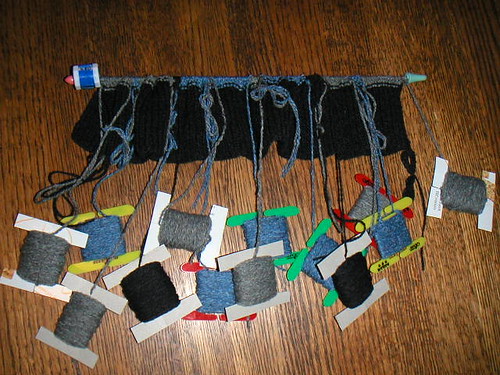Technical Bits: Lifelines
In a recent discussion on the Ravelry board for A Stitch in Time volume 1, the issue of lifelines came up in relation to the pattern Knitter's Delight.
As you can see from the image of Knitter's Delight, above, it is a lace pattern. This is where the lifelines come in... If you have never knitted lace because you are worried about messing up the pattern, or if you have tried and struggled and ended up ripping it out, then you need to know what lifelines are.
Used under Creative Commons from The Bees
Thanks, Annie!
A lifeline, in knitting terms is a safety net which provides a place to unravel your knitting back to if you make a mistake. You can see from the image above that this knitter has used a contrasting piece of crochet cotton, threaded through the stitches at a point where her lace pattern changes charts.
You might choose to use a lifeline after each lace repeat or half repeat if it is a large complicated one. Lifelines are predominantly used in lace knitting because it is difficult to tink (knit backwards to unpick) or unravel the multiple yarn-overs and k2togs that make up the pattern. However, they are a really good addition to any complicated knitting pattern, especially one using a technique that you are trying out for the first time. There's nothing stopping you adding lifelines to your fair isle, cables or anything else you fancy.
Used under Creative Commons from Dave's Portfolio
But how do you add a lifeline?
You already know that it is an extra, separate piece of yarn threaded through a row. It should be threaded through the live stitches either by using the piece of yarn on a darning needle after you have completed the last row of the repeat, or if you have interchangeable needles, you can put the yarn through the tightening hole in the cable and knit it through the last row as you go. It is possible to add a lifeline further down your knitting by using a darning needle, but this makes it more fiddly to catch all of the increase and decrease stitches.
Top tip: be careful not to thread your lifeline through a stitch marker, or it will not be possible to slip the marker on the next row.
The knitter whose work you saw in the picture above used a contrasting cotton crochet thread, so it would both be easy to see and also to remove from the knitting afterwards. Linen thread and waxed dental floss are also good to use. If you don't have any of these handy, just make sure that you use a yarn that is a lighter weight than the main yarn you are knitting with and that it has a smooth finish.Important Addition!
Annie pointed out to me that it was all very well telling you all how to make a lifeline and what it was for, but what about how to frog your knitting back and get your stitches back on the needles?!
All you need to do to rip back to the lifeline is to slip the knitting from the needles, carefully unravel the knitting (this may be more difficult if you have something which has mohair in it, like Kidsilk Haze). Once you get to the lifeline, you won't be able to unravel any further. This is the point where you will need to put the knitting back onto your needles.
Carefully insert the needle into the first stitch that has the lifeline through it, and pop it onto the needle. You can either take the lifeline out of each stitch as you go along, leave it til the last one is done, or just leave it in to continue being a lifeline (I prefer leaving it in, especially if I've gone wrong once!) Move on to the next stitch, popping it onto the needle and continue until you get to the end of the row. You will be left with a correctly knitted row which will have no dropped or twisted stitches.
Basically then you continue on as you were before, and if you make another mistake that warrants frogging a few rows, you have a lifeline there still.
Happy lifesaving!
Ingrid x
Labels: technical bits














